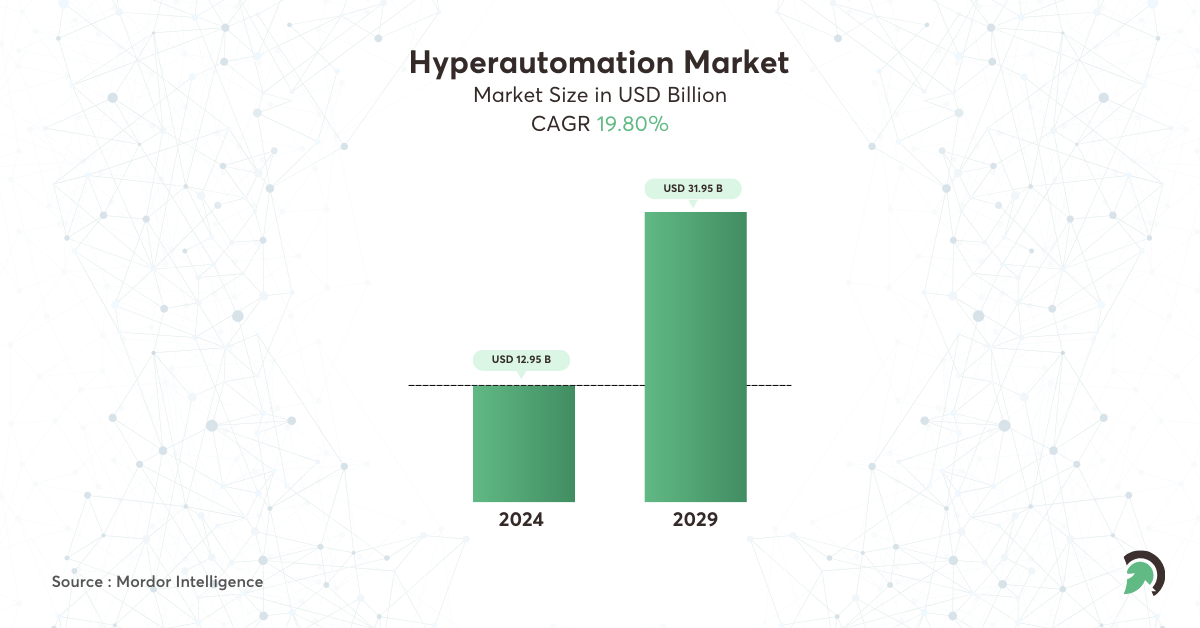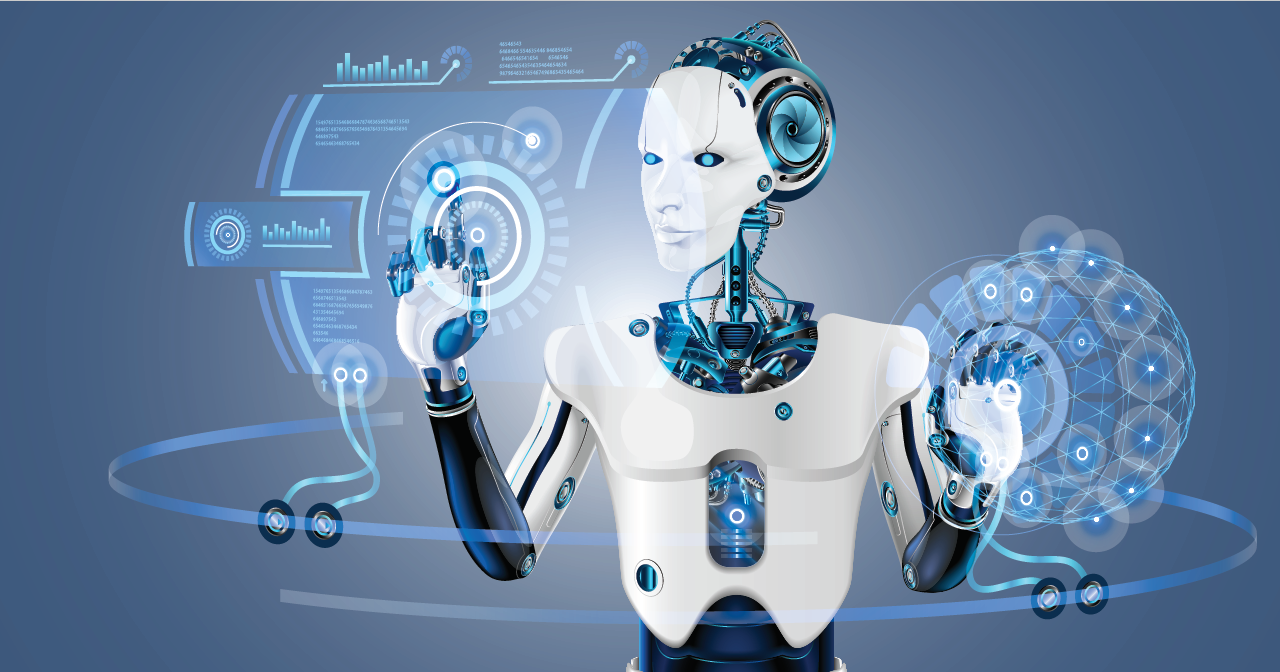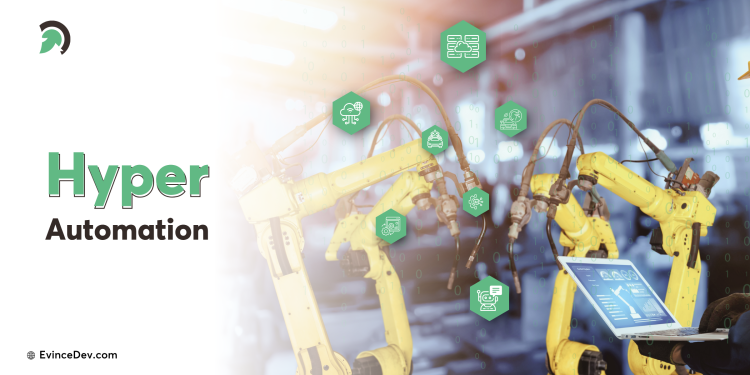Over the last few years, the buzz about Hyperautomation continues to grow, and Hyperautomation solutions have emerged as one of the most promising advancements. Many businesses hesitated to adopt automation when technology initially emerged because they feared change, costs, and loss of employment.
With technology evolution and the tried-and-tested benefits of implementing such advancements in the business world becoming evident, enterprises are moving their practices into building innovative, highly efficient, and people-centric workplaces.
As the reliability of automation tools and technology increases, so does the need to cope with the ever-evolving tech landscape and stay current with the latest trends.
A step-leading automation, hyper-automation is a potential growth opportunity for businesses seeking to keep pace with the growing market and get a competitive edge. Many tech leaders are optimistic that it is the future of work, and to a business, it’s not just a potential opportunity but rather an unavoidable change.
In the guide, we’ll examine what hyper-automation is, how it works, and why it benefits businesses.
What is Hyper-Automation?
Hyperautomation is a strategic and structured way for organizations to quickly identify, evaluate, and automate business and IT processes. It involves the use of multiple technologies like artificial intelligence (AI), machine learning (ML), robotic process automation (RPA), and more.
According to Gartner, hyper-automation can create a digital twin of the organization (DTO). Hyper-automation software allows organizations to see how their functions, processes, and key performance indicators (KPIs) interact to create value.
The DTO becomes integral to the hyperautmation process, providing real-time strategic business intelligence to drive opportunities.
Key Statistics About Hyper-Automation
- The market size of Hyperautomation is projected to be approximately USD 12.95 billion in 2024, with expectations to surge to USD 31.95 billion by 2029 at a CAGR of 19.80%.

- A survey of Global 500 companies reveals that businesses opt to invest in AI and automation tools and predict substantial growth in the coming years.
- Hyperautomation adoption is on the rise, with 34% of organizations integrating it primarily to enhance employee productivity.
- According to Gartner’s estimations, by 2024, businesses are predicted to reduce operational costs by 30% by integrating hyper-automation technologies with revamped operational procedures.
Difference between Automation vs. Hyper automation
Automation and hyper-automation are similar but different terms, so people often need clarification. Let’s look at both terms separately.
| Feature | Automation | Hyperautomation |
|---|---|---|
| Scope | Limited to repetitive tasks | Encompasses end-to-end processes |
| Technology Used | Primarily RPA-based | Utilizes AI, ML, RPA, and other advanced technologies |
| Flexibility | Relatively rigid and predefined | Highly adaptable and scalable |
| Decision Making | Rule-based | Intelligent decision-making capabilities |
| Scalability | May have scalability limitations | Designed for scalability across various business functions and processes |
| Efficiency | Improves efficiency within specific tasks or processes | Enhances overall business efficiency by streamlining entire workflows |
| Human Involvement | May require human intervention for complex tasks | Minimizes human intervention through advanced automation capabilities |
| Business Impact | Provides incremental improvements in productivity | Drives significant business transformation and innovation |
| Integration | Limited integration capabilities | Seamlessly integrates with diverse systems |
How Does Hyperautomation Work?
Hyperautomation aims to automate as many tasks as possible, freeing employees to focus on more strategic and value-added work. Hyperautomation can also improve efficiency, accuracy, and compliance.
The first step in hyper-automation is to identify the right processes to automate. It involves looking for tasks that are rule-based, repetitive, and have a high volume of transactions.
Once the correct processes have been identified, the next step is to select the right automation technologies. RPA is the best choice for tasks that are simple and repetitive. AI and ML can be used for more complex tasks that require decision-making.
The final step is to implement the automation solutions. It involves integrating the automation technologies with the existing IT infrastructure and training employees on using the new systems.
Hyperautomation is a complex undertaking, but it can be a valuable tool for businesses looking to improve their operations.
Challenges in Implementing Hyperautomation
Implementing hyper-automation comes with its set of problems. Here’s a breakdown of some of the common challenges:
Complexity
Hyperautomation involves integrating various technologies, systems, and processes, which can introduce complexity. Managing such complexity, ensuring interoperability between different tools, and maintaining a coherent architecture poses significant issues.
Lack of Clarity and Planning
With a clear strategy and roadmap, organizations can identify the right processes to automate and the most suitable technologies. Unequal alignment between business objectives and automation initiatives can lead to inefficiencies and wasted resources.
Data Quality and Availability
Hyperautomation heavily relies on data inputs for decision-making and process optimization. Poor data quality, inconsistency, and lack of data availability can hinder the effectiveness of automation efforts. Organizations must address data governance issues and invest in data management practices to ensure reliable data for automation processes.
Change Management and Reskilling
Automation initiatives often disrupt existing workflows and require employees to adapt to new working methods. Lack of adequate training, resistance to change, and skill gaps can impede the successful implementation of hyper-automation. Effective change management strategies and investments in employee reskilling are crucial for overcoming these challenges.
Security and Privacy Concerns
Integrating various systems and technologies increases the attack surface and exposes organizations to cybersecurity threats. Also, automation processes may involve sensitive data, compliance with regulations such as GDPR and CCPA, and raising concerns about data privacy. Implementing robust security measures, ensuring data encryption, and adhering to privacy regulations are essential for mitigating these risks.
Key Components of Hyperautomation Software
Hyperautomation is about using the right mix of automation tools for your needs or a best-of-breed approach, and it doesn’t mean you need every tool out there. A thoughtful combination of the following solutions can help you achieve a successful hyper-automation strategy:
Artificial Intelligence (AI) – Robots that can perform tasks with intelligence and discernment where human involvement was once needed.
Machine Learning (ML) – Computer algorithms automatically learn and improve processes through experience and data.
Robotic Process Automation (RPA) – Low code, front-end automation best suited for repetitive, rule-based work to augment human productivity.

Secure Forms – Electronic fillable forms that automatically and securely capture data directly into your applications and systems and help you further digitally transform document processes.
Business Process Automation (BPA) – Solutions that combine business process automation tools for added functionality and capabilities
Workload Automation – Code-driven, back-end automation for centralized orchestration of scripts, batch processes, cross-platform workflows, and more.
Industries That Can Get Benefits From Hyper-Automation
Many industries stand to benefit from hyper automation’s power to increase productivity, save costs, and improve decision-making. The following industries are gaining significantly from hyper-automation:
Finance and Banking
The finance and banking sector relies on complex processes and data management. Hyper-automation can revolutionize these operations by automating repetitive tasks like data entry and transaction processing. Many banks and financial institutions have adopted advanced analytics for applicant screening, assessing a customer’s repayment capacity by analyzing various typically inaccessible parameters through manual screening methods. It reduces errors and frees up valuable time for employees to focus on more strategic and customer-centric activities.
Retail
In the fast-paced world of retail, hyper-automation can improve efficiency and customer experience. Retailers can ensure accurate stock levels, faster order fulfillment, and seamless customer interactions by automating inventory management, order processing, and customer support. It leads to increased customer satisfaction and loyalty.
Insurance
The insurance sector uses vast data and complex workflows. Hyper-automation can simplify and accelerate claims processing, policy management, and underwriting procedures. Many customers manually provide data to agencies, which must undergo additional verification and cross-referencing with client certifications during the insurance claim processing. In contrast, digital automation can efficiently gather and validate data from multiple sources, achieving higher accuracy and speed without strain than human counterparts. Insurers can minimize errors, expedite response times, and enhance operational efficiency by automating these tasks.
Government
Governments face the problem of managing numerous administrative tasks and providing efficient public services. Hyper-automation can help automate document management, citizen inquiries, and regulatory compliance processes. By employing such technology, governments can streamline operations, reduce bureaucracy, and improve service delivery to citizens.
Pharmaceuticals
The pharmaceutical industry is highly regulated and demands strict quality control and compliance adherence. Hyper-automation can assist in automating manufacturing processes, quality assurance, and regulatory reporting. It not only ensures compliance but also accelerates time-to-market for life-saving medications.
Hospitality
The hospitality industry flourishes in delivering exceptional guest experiences. Hyper-automation can play a crucial role in achieving this goal. By automating check-in and check-out processes, room service requests, and reservation management, hotels can streamline operations and reduce wait times. It can also enhance guest personalization by leveraging data to offer tailored recommendations and services.
Driving Success: How Companies Are Thriving with Effective Fleet Management
Below are real use cases showcasing successful hyper-automation implementations by the companies listed:
Maersk
- Maersk, the world’s largest container shipping company, implemented hyper-automation to streamline its logistics and supply chain operations.
They processed over 17,000 weekly transactions using AI and machine learning methods, saving nearly $36,000 annually. Furthermore, with the AI module in place, the accuracy rate increased to 97.4%, up from the teams’ average of 88%.
- Among the initiatives Maersk undertook to increase overall business efficiency was the AI-based automation of transportation and logistics bookings.
Nike
- Nike, an athletic footwear and apparel leader, partnered with Cognizant for technology support to improve customer experiences, optimize operational efficiency, and drive innovation using hyper-automation technologies.
- With a focus on multilingual IT customer service and deskside and dispatch depot services, Cognizant aims to elevate customer satisfaction and streamline support processes.
- Adopting advanced technologies such as hyper-automation, AI, and process re-engineering, the partnership can deliver new self-service capabilities, improve service productivity, and achieve significant cost savings for Nike in the retail industry over the next five years.
Unilever
- Unilever is a consumer goods company that has integrated HyperAutomation technology into its hiring procedure.
- Using AI-enabled tools to analyze candidates’ resumes based on video interviews, they have saved 100,000 hours of human recruitment time.
- They also deployed robotic process automation (RPA), IoT sensors, and predictive analytics to automate production scheduling, inventory management, and supply chain logistics in their manufacturing and distribution processes.
The above examples demonstrate how leading organizations across different industries have successfully implemented hyper-automation to drive operational excellence, improve agility, and deliver customer value.
How Can EvinceDev Help You To Implement Hyper-Automation?
While automation has been around for decades, Hyperautomation benefits businesses due to its innovative ways of helping enterprises use technology and improve operational efficiency.
When considering how Hyperautomation benefits businesses, it is essential to know that good hyper automation sotware always utilizes its expertise in BPM, RPA, Analytics, Document AI, OCR, and other technologies to drive transformation in enterprises.
With EvinceDev, a custom software development company, organizations can confidently start their journey toward digital transformation, knowing they have the expertise and support needed to navigate the complexities of hyper-automation and emerge as industry leaders in the digital age. If you need assistance regarding the best-tailored software for your specific needs, contact us for a FREE consultation and learn more about software development services.




